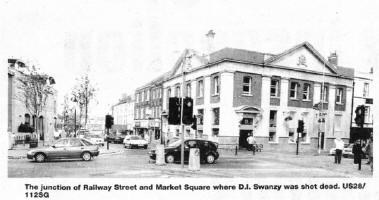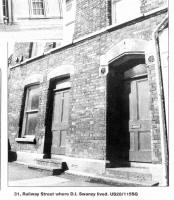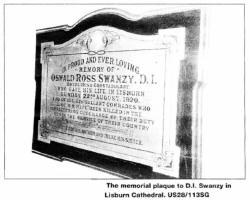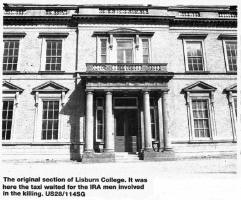
Assasination of Detective Inspector Oswald Ross Swanzy
IRA KILLED RIC DETECTIVE INSPECTOR
AS HE LEFT MORNING SERVICE AT CATHEDRAL
New book describes Market Square murder 80 years ago
 |
 |
| The junction of Railway Street and Market Square where D. J. Swanzy was shot dead. US626 | 31, Railway Street where D. I. Swanzy lived |
A MURDER in Market Square almost 80 years ago which took place against a background of political turmoil in the run up to the partition of Ireland is recalled in a newly published book. 'Police Casualties in Ireland 1919 to 1922' by serving RUC Inspector Richard Abbott looks at the losses suffered by the Royal Irish Constabulary during this period which included the bloody Anglo Irish War.
Many of the incidents listed prior to partition took place in Dublin, Cork and other southern towns and cities.
However, one local exception was the murder of Detective Inspector Oswald Ross Swanzy on Sunday August 22, 1920.
According to the book the officer lived at 31, Railway Street and on the date in question had attended Morning Service at the Cathedral.
At l .06pm as he was walking past the entrance to the Northern Bank (now Shannon's Jewellers) when he was shot by the IRA and died at the scene.
A 39 year old single man from Co. Monaghan he had been a member of the police for 15 years. His funeral took place at Mount Jerome Cemetery in Dublin three days later.
The following February a memorial was erected in the north wall of the Cathedral by his mother and sister.
The brass tablet mounted in Irish Oak bore the following inscription.
MEMORY
 'In
proud and loving memory of Oswald Ross Swanzy DI Royal Irish
Constabulary who gave his life in Lisburn on Sunday August 22,
1920 and his gallant comrades who, like hum, have been killed
in the unfaltering discharge of their duty and in the service
of their country. Be thou faithful unto death and I will give
you a crown of life."
'In
proud and loving memory of Oswald Ross Swanzy DI Royal Irish
Constabulary who gave his life in Lisburn on Sunday August 22,
1920 and his gallant comrades who, like hum, have been killed
in the unfaltering discharge of their duty and in the service
of their country. Be thou faithful unto death and I will give
you a crown of life."
But why did the IRA choose to murder Mr. Swanzy in an operation which at the time must have presented them with logistic problems?
In his book Mr. Abbott says the decision to kill the Detective Inspector was taken by Michael Collins himself who believed the officer had been the leader of the party of unidentified men who killed Tomas McCurtain, the Lord Mayor of Cork and Commandant of Cork Number One Brigade of the IRA.
With the help of RIC Sergeant Matt McCarthy who had provided Collins with information in the past, DI Swanzy was traced to Lisburn.
The Intelligence Officer of B Company of the IRA's First Cork Battalion Sean Culhane was then sent to Belfast to link up with local IRA activists. On the day of the attack Culhane and a number of Belfast IRA men left the city in a taxi and made their way to Lisburn.
 Culhane, and a Belfast member of the IRA called Roger
McCorley walked up to the officer and shot him at close range.
Culhane, and a Belfast member of the IRA called Roger
McCorley walked up to the officer and shot him at close range.
They and their accomplices then ran in pairs along Castle Street with another man in the middle of the road.
They continued to fire as they made their way to the taxi which was waiting outside the Technical College.
The vehicle started to move off before McCorley reached it and he was forced to throw himself into the car.
As he did so he landed in a heap on the back floor of the car and accidentally fired a round from his revolver inside the taxi.
A member of the public noted the taxi's number as it left Lisburn and the driver was arrested later that afternoon.
He told police he worked for the Belfast Motor Cab and Engineering Co. at Upper Library Street. At 11.45am, he said, he had been sent to the Great Northern Railway Station in Great Victoria Street to collect a fare who wanted to 'take a run along the Co. Down coast'.
The taxi driver was later tried for the killing of DI Swanzy but found not guilty.
|
Killing led to murder and sectarian mayhem THE IRA killing of Detective Inspector Swanzy led to bitter sectarian rioting in Lisburn. A number of Catholics were murdered and others assaulted and terrorised as their homes and businesses were burned by mobs on the rampage. Journals kept at the time recall how groups of people waited at Lambeg to attack Catholics fleeing the town on the main Belfast Road. This forced many to leave Lisburn by way of the mountain route into the city as columns of smoke rose into the air above the town. Workers at local mills were also called upon to sign the following declaration: 'I.... ...hereby declare I am not a Sinn Feiner nor have any sympathy with Sinn Fein and do declare I am loyal to king and country'. Violence also swept across Belfast in the wake of the Market Square attack. A total of 22 people were killed in one week and on August 24 the authorities swore in a number of special constables to try to regain control of the situation. This was the first time since the start of the IRA campaign in 1919 Special Constables had to be used. On November 1, 1920 they were introduced on a formal organised basis. The Detective Inspector's family had a long connection with Lisburn. He had a direct ancestor Henry from Blaris who was baptised in the same cathedral outside which Mr. Swanzy was to die 264 years later. In 1689 Henry joined a local regiment raised by Colonel Arthur Upton and after the Battle of the Boyne settled at Arelreagh, Co. Monaghan. You can read more about Lisburn riots that followed the murder, or The Burnings as they were known, on this page. |
Troubles in 1920's brought grief to many homes
THE troubles of the early 1920's brought grief to many homes throughout the Lagan Valley area.
The grave of Special Constable George Connor in Lisburn Cemetery had to be dug after he was attacked while on duty in Belfast with the RIC. The incident occurred on May 25, 1922 at McCauley Street just off Cromac Street.
A number of men were seen acting suspiciously during a curfew and it appeared they had set fire to a building to draw police into an ambush.
A police patrol went to the area and the Senior Constable was helping to evacuate adjoining houses when he was shot by an IRA sniper and wounded. He succumbed to his injuries the following day.
During the First World War he had served with the Royal Irish Rifles.
The grave of Special Constable Thomas Cunningham is located in Newtownbreda Cemetery.
He died on March 23, 1922 at May Street in Belfast City Centre.
At 12.15pm he and Special Constable William Chermside turned into the street from Victoria Street when IRA men came up beside them and fired a number of shots from revolvers.
Both died shortly after the attack from the wounds they received. The IRA killing of the Divisional Police Commissioner for Munster in The Country Club, Cork City on July 17,1920 also had repercussions for the local area.
Gerard Brice Ferguson Smyth was shot dead in the smoking room of the club.
He was buried in the family burial ground at Newry Road Cemetery in Banbridge.
Subsequent rioting in nearby Dromore led to the death of one local person.
There were also fatalities in violence which broke out in Belfast.
28/07/2000
